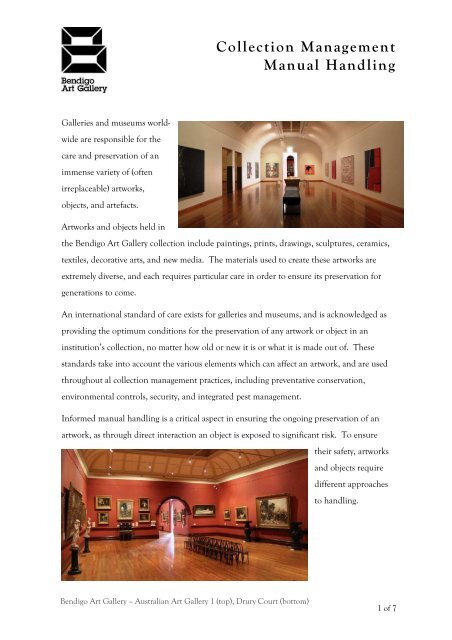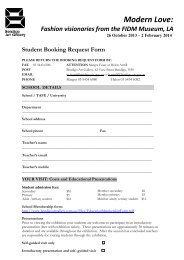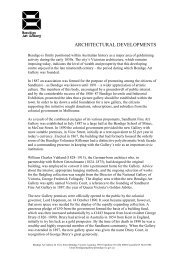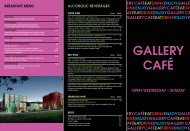Collection Management Manual Handling - Bendigo Art Gallery
Collection Management Manual Handling - Bendigo Art Gallery
Collection Management Manual Handling - Bendigo Art Gallery
Create successful ePaper yourself
Turn your PDF publications into a flip-book with our unique Google optimized e-Paper software.
<strong>Collection</strong> <strong>Management</strong><br />
<strong>Manual</strong> <strong>Handling</strong><br />
Galleries and museums worldwide<br />
are responsible for the<br />
care and preservation of an<br />
immense variety of (often<br />
irreplaceable) artworks,<br />
objects, and artefacts.<br />
<strong>Art</strong>works and objects held in<br />
the <strong>Bendigo</strong> <strong>Art</strong> <strong>Gallery</strong> collection include paintings, prints, drawings, sculptures, ceramics,<br />
textiles, decorative arts, and new media. The materials used to create these artworks are<br />
extremely diverse, and each requires particular care in order to ensure its preservation for<br />
generations to come.<br />
An international standard of care exists for galleries and museums, and is acknowledged as<br />
providing the optimum conditions for the preservation of any artwork or object in an<br />
institution’s collection, no matter how old or new it is or what it is made out of. These<br />
standards take into account the various elements which can affect an artwork, and are used<br />
throughout al collection management practices, including preventative conservation,<br />
environmental controls, security, and integrated pest management.<br />
Informed manual handling is a critical aspect in ensuring the ongoing preservation of an<br />
artwork, as through direct interaction an object is exposed to significant risk. To ensure<br />
their safety, artworks<br />
and objects require<br />
different approaches<br />
to handling.<br />
<strong>Bendigo</strong> <strong>Art</strong> <strong>Gallery</strong> – Australian <strong>Art</strong> <strong>Gallery</strong> 1 (top), Drury Court (bottom)<br />
1 of 7
<strong>Collection</strong> <strong>Management</strong><br />
<strong>Manual</strong> <strong>Handling</strong><br />
1. To Glove, or Not To Glove?<br />
Gloves are worn to prevent<br />
the oils and acids from your<br />
skin from marking and<br />
damaging the surface of the<br />
work.<br />
Fingerprints may not show up immediately; in the<br />
case of photographs and silver, it may take several years to etch into the surface. However,<br />
once the fingerprints are there they cannot be removed.<br />
o Nitrile gloves – framed work, metals, textiles, some ceramic (unglazed) and glass<br />
o Riggers gloves (also nitrile) – heavy objects<br />
o Bare hands (clean) – glazed ceramic, some heavy objects<br />
o Cotton gloves were once used extensively, however they do not provide adequate<br />
tactility and grip to safely handle many object types or mediums<br />
o If artworks are in packing material they are carried without gloves, as this is allows for<br />
a safer grip.<br />
A packed artwork must still be handled with full<br />
consideration for its material content and<br />
construction.<br />
Top, from left to right – nitrile, riggers, and cotton gloves.<br />
Bottom – examples of signage used at Victoria & Albert Museum,<br />
and the British Museum<br />
2 of 7
<strong>Collection</strong> <strong>Management</strong><br />
<strong>Manual</strong> <strong>Handling</strong><br />
2. <strong>Handling</strong> Processes<br />
The handling and movement of artworks and objects is undertaken only when necessary, and<br />
minimised wherever possible, as this reduces the risk of any damage to the work.<br />
Individuals involved in the movement of collection objects must<br />
have physical surety and confidence, balanced with attention to<br />
detail and an understanding of taking things at a steady<br />
(sometimes extremely slow) pace.<br />
A gung-ho attitude and<br />
impatience is guaranteed to<br />
be a disastrous combination.<br />
Specialist contractor J.K. Fasham’s relocates<br />
‘The Wrestler’ from the upper loading bay<br />
to the Sculpture Annexe in March 2011.<br />
3 of 7
<strong>Collection</strong> <strong>Management</strong><br />
<strong>Manual</strong> <strong>Handling</strong><br />
Processes are put in place to assist with safe movement:<br />
o Use of mechanical aids – trolleys, dollies, a-frames, pallet jacks<br />
– wherever possible, as this minimises accidents resulting from<br />
human error.<br />
o Whenever moving an artwork ensure the path is clear of<br />
obstacles. If moving the object through a public space, use a<br />
‘spotter’ to go ahead of the artwork and navigate.<br />
o The artwork should not be handed to another person. The<br />
work is put down (on a clean surface), allowing the other<br />
person to pick it up.<br />
o When moving large and/or heavy works, ensure there are<br />
enough people available to move the work safely.<br />
o A team leader is appointed, who will assess the<br />
movement required, and give clear concise instructions<br />
to the team at the beginning of each movement.<br />
o Time – it is critical that enough time is factored in to any<br />
object movement, to ensure personnel are not felt hurried.<br />
Framed artworks are moved on an A-Frame (middle), and smaller 3D works (ceramics,<br />
sculpture) are where possible kept in their boxes and moved on trolleys (top). Bottom:<br />
travelling exhibitions and sculptures often arrive in crates and are moved using dollies.<br />
4 of 7
<strong>Collection</strong> <strong>Management</strong><br />
<strong>Manual</strong> <strong>Handling</strong><br />
3. Exhibition Installation<br />
Preparation<br />
o Planning a schedule – the more complex the<br />
exhibition, the more detailed the schedule<br />
o Ensure the right equipment and tools are available<br />
o Protection of objects and personnel – what is safe for<br />
artworks is generally safe for people, due to the care<br />
taken to ensure the object’s safety<br />
Installation<br />
o Established proven methods are used constantly, and<br />
taught to new/temporary staff and contractors<br />
o Resourcing – teams are available and used as<br />
necessary to suit any given situation<br />
o Correct manual handling procedures are observed at<br />
all times<br />
Adequate time is taken to ensure safe installation<br />
A technician does the math for a hang in Australian <strong>Art</strong> <strong>Gallery</strong> 2 (top).<br />
Consultants, contractors, <strong>Bendigo</strong> <strong>Art</strong> <strong>Gallery</strong> and Victoria & Albert Museum staff remove a<br />
1930s wedding gown from its crate (bottom).<br />
5 of 7
<strong>Collection</strong> <strong>Management</strong><br />
<strong>Manual</strong> <strong>Handling</strong><br />
o 4. Storage<br />
The environmental conditions<br />
within a museum or gallery’s<br />
storage facility should be the same<br />
as the display areas.<br />
o Framed works are stored<br />
on space-saving movable<br />
racks, which have enough<br />
space between them to<br />
ensure that artworks will<br />
not come into contact.<br />
o Unframed work on paper is stored in plan drawers or solander boxes, depending on<br />
the size of the work. Archival (acid-free) card and tissue is used to separate one<br />
artwork from another.<br />
o 3D work – large sculpture, small sculpture, ceramic, decorative art – can be stored on<br />
open shelving, in crates or boxes, or<br />
palletised.<br />
o If open shelving or pallets are used, ideally<br />
dustcovers are placed directly over the work<br />
(large sculpture), or over the shelving, to<br />
minimise any build up of surface dirt.<br />
Framed works on movable racks (top); unframed work on paper in solander boxes<br />
(middle); decorative arts on open shelving (bottom).<br />
6 of 7
<strong>Collection</strong> <strong>Management</strong><br />
<strong>Manual</strong> <strong>Handling</strong><br />
Crating is most often used when sending an artwork away on loan; the crate can then<br />
also be used to permanently store the work.<br />
o Crates are made to suit an individual 3D artwork (or set of framed 2D works), and<br />
will have trays, supports, foam blocks and padding cut and installed for the safety of<br />
that specific work.<br />
o Travelling frames are made for framed 2D works or paintings on stretchers. Those<br />
travelling short distances may only be soft packed, depending on the number of<br />
destinations, and fragility of item.<br />
o Archive boxes include constructed<br />
solander boxes, and archival (blue-board)<br />
board boxes.<br />
o Soft packing is the use of soft materials<br />
such as bubble wrap, cellaire, foam, and<br />
tissue with or without the use of boxes or<br />
a surrounding framework for objects.<br />
Jan Nelson’s sculpture ‘Walking in Tall Grass (Blackwood)’ is housed in a crate whenever it is<br />
not on display.<br />
Examples of crating and travelling frames made by a Melbourne-based industry provider, TED.<br />
7 of 7
















